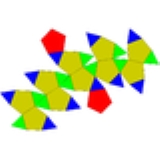
Pentagonal orthobirotunda
Encyclopedia
In geometry
, the pentagonal orthobirotunda is one of the Johnson solid
s (J34). As the name suggests, it can be constructed by joining two pentagonal rotunda
e (J6) along their decagon
al faces, matching like faces. A 36-degree rotation of one rotunda before the joining, so that pentagons abut triangles and vice versa, yields an icosidodecahedron
, one of the Archimedean solid
s.
The 92 Johnson solids were named and described by Norman Johnson in 1966.
Geometry
Geometry arose as the field of knowledge dealing with spatial relationships. Geometry was one of the two fields of pre-modern mathematics, the other being the study of numbers ....
, the pentagonal orthobirotunda is one of the Johnson solid
Johnson solid
In geometry, a Johnson solid is a strictly convex polyhedron, each face of which is a regular polygon, but which is not uniform, i.e., not a Platonic solid, Archimedean solid, prism or antiprism. There is no requirement that each face must be the same polygon, or that the same polygons join around...
s (J34). As the name suggests, it can be constructed by joining two pentagonal rotunda
Pentagonal rotunda
In geometry, the pentagonal rotunda is one of the Johnson solids . It can be seen as half an icosidodecahedron.The 92 Johnson solids were named and described by Norman Johnson in 1966.-Formulae:...
e (J6) along their decagon
Decagon
In geometry, a decagon is any polygon with ten sides and ten angles, and usually refers to a regular decagon, having all sides of equal length and each internal angle equal to 144°...
al faces, matching like faces. A 36-degree rotation of one rotunda before the joining, so that pentagons abut triangles and vice versa, yields an icosidodecahedron
Icosidodecahedron
In geometry, an icosidodecahedron is a polyhedron with twenty triangular faces and twelve pentagonal faces. An icosidodecahedron has 30 identical vertices, with two triangles and two pentagons meeting at each, and 60 identical edges, each separating a triangle from a pentagon...
, one of the Archimedean solid
Archimedean solid
In geometry an Archimedean solid is a highly symmetric, semi-regular convex polyhedron composed of two or more types of regular polygons meeting in identical vertices...
s.
The 92 Johnson solids were named and described by Norman Johnson in 1966.

